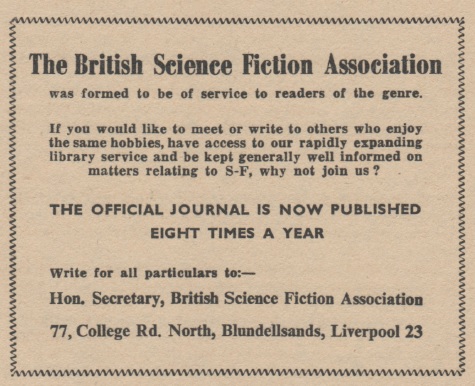
by Mark Yon
Scenes from England
Hello again!
We seem to be on a bit of a roll at the moment with the British magazines. Generally, there are more stories that are good than bad, and even some really, really good. Whilst the experimental stuff can be a mixed bag, there’s no denying that what we are reading now is *cough* “worlds away” from the generic stuff we were reading ten years ago.
Even comparing the British material with the US magazines shows some clear differences.
And yet at the same time there are worrying rumours that subscriptions are declining, especially that of SF Impulse, which has always been the less popular of the two, and – whisper it softly – the reason for SF Impulse having to bring in a new Editor, Harry Harrison, to try and slow the decline.
Both magazines are bringing readers new ideas and new stories every month – except that both magazines have had to include “classic” stories recently, presumably in part because they are cheaper to republish.
I hope that the rumours aren’t true, but it is a little worrying.
Nevertheless, for now, it’s full steam ahead, but with regular glances to the horizon. Like last month, I’ll start with New Worlds.

This month Mike Moorcock’s Editorial poses the question: “Are there too many science fiction books being published?” Usually to questions like this I would say “Absolutely not!” and then move on, but Mike makes the point that because most of the books published are mediocre, the shop shelves are filled with banality that obscures the ones worth reading and gives sf a reputation for unchallenging and poor reading material. Not sure that I entirely agree, but it means that the Editorial does that thing it should do – of making the reader think and perhaps take a look at something from a different angle before moving on.
Let’s hope the argument doesn’t extend to ”Are there too many British science fiction magazines being published?”
To the stories!

Illustration by James Cawthorn
Storm Bird, Storm Dreamer, by J. G. Ballard
The cover story first. More depressingly dystopian prose from J. G., although this one is more straight-forward than some of his recent efforts. A near future landscape shows a world in environmental chaos. One of the side-effects has been that in Daphne du Maurier style the birds have started attacking humans. Captain Crispin spends much of his time shooting them in a constant battle between Man and bird. He also meets Catherine York, who oddly spends her time collecting dead bird’s feathers and leaving them to dry. These two odd characters develop an unusual relationship that doesn’t end well. The reason for York’s strange behaviour is explained at the end.
This one has the usual dramatic prose from Ballard, with vivid descriptive paragraphs, but in a more straight-forward narrative than his cut-up stories. It reminded me of his piece Dune Limbo, published in the March 1965 issue of New Worlds, where the not particularly pleasant characters attempt to survive in a challenging landscape. Never the happiest of settings, nevertheless the bleakness of Ballard’s more linear narrative makes this one more memorable to me. 4 out of 5.
The Flight of Daedalus, by Thomas M. Disch
And from one type of flight to another. The third month in a row from Disch. This time it is poetry, subtitled “fragment of an abandoned poem” and something Moorcock is still determined to include in the magazine. And whilst it is not my thing, as I have said before, it is fair. 3 out of 5.
A Man Must Die , by John Clute
Another story of flight – anyone would think that there’s a theme here! – but this time about a young man’s determination to run away from the guiding hands of Mother to Father. The main point of the story is that young Picasso Perkins III is the son of a spaceship’s captain, and much of the story is about how he is being educated to take on that role in the future and what happens when he does. Lots to like here in that Clute takes fairly traditional themes and gives them a spin under new management, with some rather surreal, trippy scenes. 3 out of 5.
Flesh of my Flesh , by J. J. Mundis
A new name, and another of those pseudo-religious diatribes that uses religious devotion to try and make a story, full of religious visions and angst. I very rarely like these, but it is done well enough. 3 out of 5.
The Thinking Seat, by Peter Tate
A name that has been quite prominent in the last few months, last seen with The First Last Martyr in the August issue of SF Impulse. Readers seem to really like Peter’s stories, but they never really impress me.
This one’s slightly better – an environmental tale that combines hip poetry with a range of weird and unlikeable characters in a dystopian future frontier town in California. The setting is Ballardian in its depressing-ness, whilst the characters seem to be full of important phrases but otherwise impotent. Feels like the author’s trying to be like Samuel L. Delany or Anthony Burgess, with less success, but it is a fair effort to be different. 3 out of 5.
The Poets of Millgrove, Iowa, by John T. Sladek
Another American big-hitter. This one does that Ballardian thing of sub-dividing the prose into short chapters. It tells of an American astronaut and his wife Jeanne being paraded out at the Millgrove Harvest Festival parade. Like Ballard’s tales, or perhaps John Brunner’s, lots of cultural brand-names bandied around to show that American heroes are being commercialised and sanitised as with any other product. It is interesting to read an American take on the themes that Ballard often uses so well. I can see why Moorcock would like it: it is meant to shock. 4 out of 5.
The Garbage World (Part 2 of 2), by Charles Platt
We continue the environmental theme with the second part of this story. In the first part we were told of Kopra, a world used by the rest of the Belt to dump its waste, and how a construction team were to begin to build a gravity generator to stop the planet destroying itself and becoming an environmental hazard. Recently deposed ‘mayor’ Isaac Gaylord had had his personal wealth stolen and blaming the nomads from outside of the village for taking advantage of the new situation goes to retrieve it with his daughter Juliette and her new boyfriend Lucian Roach. Whilst travelling around a mud lake their tractor had broken down and their radio was stolen, leaving them stranded.
In this installment, Gaylord returns to the village and Lucian finds that there is a devious plot by the outsiders to actually destroy, not save, Kopra. Roach confirms that he is in love with Juliette and goes native. The Kopra-ites escape the planet, and the story ends with an orgy on a spaceship as the planet explodes. (Outside of Heinlein, does this sort of story gain traction anywhere else but in Britain?)
As such a description shows, the cliff-hanger ending last time deteriorates into a pulpy space opera type tale. I was hoping that the story would raise itself above its crass beginning, but sadly it was not to be. Whilst I still think that there’s some good descriptions of this most unusual planet in here, the simple characterisation means that the tale is basically an old-school “planetary explorer” story with sex. 3 out of 5.
The Tennyson Effect, by Graham M. Hall
A new name to me, I think. This story is one of those experimental prose streams of consciousness that try to tell a lot but actually do little. Not for me, I’m afraid. 2 out of 5.

Illustration by James Cawthorn
The Realms of Tolkien, by Daphne Castell
An unusual point here, being an article from a writer that we’ve usually known for her fiction. What Daphne does here is tell us of the fantasy that has really caught on in the US, I gather. Most interestingly the article tells of an interview Daphne has had with the reclusive Professor Tolkien about his work and gives the reader both an idea of the story and through discussion with Tolkien a flavour of the complexity of Tolkien’s world. Whilst it is not unbiased, the article clearly shows a detailed knowledge of Tolkien’s writing and makes some interesting points as to his success.

Illustration by James Cawthorn
Book Reviews
This month, just one book – Michael Orgill discusses the collection The Voices of Time, edited by J. T. Fraser. It is “a massive study of the problem of time”. The review covers what is good, bad and interesting in the book, and overall “there is a lot to admire.”
No Letters pages again this month.
Summing up New Worlds
Another generally good issue with a combination of new writers and imported Americans who are determined to push the boundaries. I am intrigued by the environmental slant of many of the stories this month, though Moorcock does not seem to make a big deal out of it, choosing instead a flight connection. The experimental stuff still works with varying degrees of success to my mind, although the Editor deserves credit for not sticking to the expected ideas and styles of science fiction.
The Second Issue At Hand

And now to SF Impulse, under the rule of its new editor Harry Harrison. There are signs of changes, this month. We have book reviews and a letters section amidst the fiction.
The Ice Schooner (part 1 of 3) by Michael Moorcock

Illustration by Keith Roberts
To begin with, though, here we have the editor of New Worlds as an author in SF Impulse. To be fair, Mike was an author long before he was the editor of New Worlds, and after his last effort of fiction (Behold, the Man! in the September issue of New Worlds, I was interested to see where this one went.
It is very different. The Ice Schooner is set in some sort of science fantasy setting, with elements of sf but set on a future icy Earth that seems to be straight out of the old adventure pulps.
Konrad Arflane is a man of the ice in a post-Nuclear future where the world is ice-covered and whales have adapted to living on the ice. Humans live in the eight cities of the Matto Grosso between which boats travel on the ice to trade or to hunt the whales as a major food source. Arflane is travelling the ice wastes when he sees a person crawling across the ice. Impressed by the man’s determination to go somewhere, Arflane rescues him. The man is a Friesgaltian aristocrat, which makes his place on the ice even more mysterious.
Taking him to Friesgalt, Arflane discovers that the man is Ship Lord Pyotr Rorsefne of Friesgalt, who is grateful for his rescue. Whilst Rorsefne recovers, Konrad is asked to stay in the Ship Lord’s home, although the lord’s son in law makes him uncomfortable. Konrad is shown a ship belonging to Rorsefne, the Ice Flame, and he becomes restless. He meets an old friend, Captain Jarhan Brenn of the Tender Maiden, and in a bar together they meet legendary harpoonist Long Lance Urquart, who tells everyone of a major herd sighted in the South Ice fields. The next day Pyotr tells Konrad that he would like him to take on a journey to the North where lies the legendary city of New York, where proof of climate change will show that the world is changing again. The story ends on a cliff-hanger as Manfred, Arflame and Janek and Ulrica Ulsenn first agree to go hunting.
I liked it a lot. It reads like some sort of post-apocalyptic Norse fantasy, sort of Moby Dick meets Poul Anderson, and whilst the characters are not particularly original, I enjoyed the imaginative setting very much. As a straight-forward Jules Verne type of tale it is very good, an adventure tale of the old-school, but much, much better than the Platt effort in New Worlds this month. I’m looking forward to seeing where this one sails to in the next issue. Nice to see Kyril Bonfiglioli get the credit for buying this one, too. Like most of Kyril’s material under his editorship, The Ice Schooner is entertaining, if rather unoriginal. 4 out of 5.
Book Fare by Tom Boardman
Aldiss’s review last month of The Clone by Theodore L Thomas and Kate Wilhelm has now developed into a review column. Tom Boardman looks at Frederik Pohl’s A Plague of Pythons and Hal Clements’ Close to Critical. Both show a range in sf – one is more about Sociology, the other a harder sf – and whilst neither are the author’s best, they are both worth reading for different reasons.
The Simple for Love, by Keith Roberts
An Anita (the teenage witch) story! Anita falls in love with a human – a Catholic – and leaves Granny and Foxhanger for him. A surprisingly romantic story from Roberts, this one, with some interesting ideas of the bigger coven network and witchcraft generally. I have grown to like these stories more and more, although I will be the first to admit that the premise is rather silly. 4 out of 5.
Stop Seventeen by Robert Wells
The story of someone (Hart) on an underground train that seems to be forever travelling as after the Apocalypse the system has gone to automatic. Clearly a metaphor for life in general, this one read well. Not entirely pointless, I found myself humming The Beatles’ “Ticket to Ride” whilst reading this one. Not entirely sure whether that is a good thing or a bad one! The ending is rather a let-down, though. 3 out of 5.
Letters to the Editor
Another innovation intended to appeal to the regular reader. One of the letters is from Brian Stableford, who we came across in last month’s Sf Impulse. There are also mentions here of the change in editorship and Keith Roberts responds to a letter about Pavane. Interesting approach in that the author is allowed to respond to the letter-writer.

Illustration by Keith Roberts
The Eyes of the Blind King by Brian W. Aldiss
Another Aldiss tale. The title immediately reminded me of the story The Day of the Doomed King published in Science Fantasy in November 1965. This is deliberate – the same setting but an earlier tale. This time it is a story of deposed and deliberately blinded King Jurosh and seven-year-old Prince Vukasan in Byzantium. Jurosh is wanting to return to Serbia and take back his throne from brother Nickolas. It is a tale of loyalty, murder and betrayal, which is quite violent. This one reminds me of Thomas Burnett Swann’s stories, mixing fantasy with a quasi-historical setting, which for me can only be a good thing. It is as good, if not better than, the first story. 4 out of 5.

Illustration by Keith Roberts
The Roaches by Thomas M. Disch
Another Disch story this month. This one ramps up the psychological horror, a story of how these troublesome insects can force people to leave their apartment. Although we don’t get cockroaches here in Britain, this one did make my skin crawl, which is quite an achievement. 4 out of 5.
SF Film Festival by Francesco Blamonti
Although we had brief reports of Loncon, I don’t think we’ve had a review of a film festival since the Carnell days of New Worlds. This is about the Fourth Annual Festival of Science Fiction Films, held in Trieste in Italy. A good time seems to have been had by many, and there is mention of various films made and authors such as Harry Harrison and Arthur C Clarke who attended. Does feel a little like filler though, even if you could argue that the magazine is trying to broaden its appeal.
Pasquali’s Peerless Puppets by Edward Mackin
The return of a popular character is usually a crowd-pleaser, and so it is here with Edward Mackin’s character Hek Belov. Down on his luck (again), cyberneticist Belov is offered work by Meerschraft – a modern entertainer wishes to resurrect puppeteer Pasquali’s act to a new generation but has found that Pasquali disappeared with the secret of his trade. Belov is persuaded to use his skills to try and resurrect the robotic puppets, but finds a bigger plan at work. It feels a little like a sub-par Asimov Robot story, but I quite enjoyed this one. The style is humorous, yet knowing. 3 out of 5.
Summing up SF Impulse
Interesting issue this one. Nothing I disliked and a lot I did. The changes have started to happen, and Harrison (and Roberts) deserve credit for trying to regenerate the magazine. My only concern is that SF Impulse now reads like New Worlds’ shy cousin – not that different and possibly of lesser interest, overshadowed by its more flamboyant centre-stage-hugging member of the family. Is there room in the British market for both? I hope so, but I’m not sure.
Despite all of this, I liked the issue a lot. Like New Worlds, there’s a mixture of new and regular writers, and some range in the stories. Whilst the stories may be less experimental than this month’s New Worlds, there’s a lot I enjoyed.
Summing up overall
So: which one did I like most? SF Impulse is clearly trying to find a new way forward, if not perhaps as ‘New Wave’ as its more noticeable sibling. Both issues were good, the Ballard story startlingly so, the Moorcock surprisingly so. New Worlds has more troubling, more edgy, more in-your-face content, but is also more prone to stories I like less.
With that in mind, then, and on enjoyment alone, SF Impulse again has it, despite my concerns mentioned above. But is it enough to make that difference in sales? Time will tell.

Until the next…

![[October 24, 1966] Birds, Roaches and Rings, <i>New Worlds</i> and <i>SF Impulse</i>, November 1966](https://i0.wp.com/galacticjourney.org/wordpress/wp-content/uploads/2021/10/New-Worlds-SF-Impulse-November-66.jpg?resize=672%2C372)

![[December 28, 1965] God-Birds and Dreams <i>Science Fantasy</i> and <i>New Worlds</i>, January 1966](https://i0.wp.com/galacticjourney.org/wordpress/wp-content/uploads/2020/12/Science-Fantasy-NW-Jan-1966.jpg?resize=672%2C372)






![[June 12, 1965] The Number of the Bests](https://i0.wp.com/galacticjourney.org/wordpress/wp-content/uploads/2020/06/wollheim-cover.png?resize=382%2C372)




![[March 28, 1965] Detectives, Curses and Time Travel <i>New Worlds and Science Fantasy, March/April 1965</i>](https://i0.wp.com/galacticjourney.org/wordpress/wp-content/uploads/2020/03/SCF-April-1965-1.jpg?resize=461%2C372)





![[June 28, 1964] Not Quite What You Think. ( <i>New Worlds, July-August 1964</i>)](https://i0.wp.com/galacticjourney.org/wordpress/wp-content/uploads/2019/06/640628cover.jpg?resize=563%2C372)

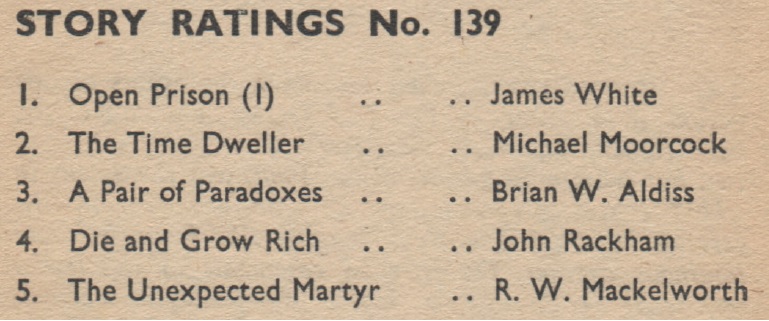

![[April 28, 1964] Out With the Old…. (<i>New Worlds, May-June 1964</i>)](https://i0.wp.com/galacticjourney.org/wordpress/wp-content/uploads/2019/04/640428cover.jpg?resize=555%2C372)

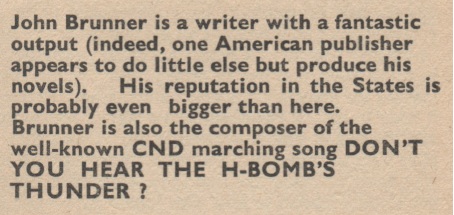
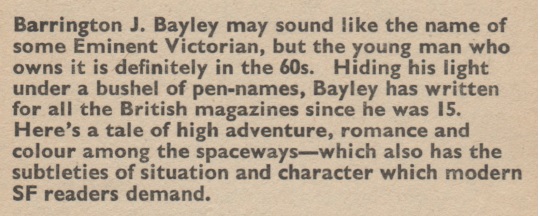




![[March 27, 1964] The End of an Era? Not With a Bang…. ( <i>New Worlds, April 1964</i>)](https://i0.wp.com/galacticjourney.org/wordpress/wp-content/uploads/2019/03/640327cover.jpg?resize=409%2C372)

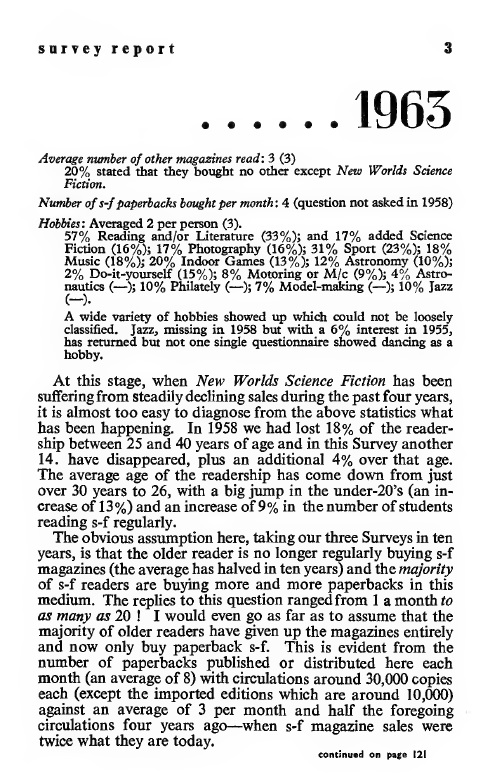
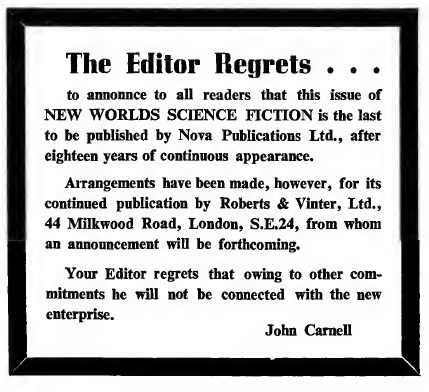
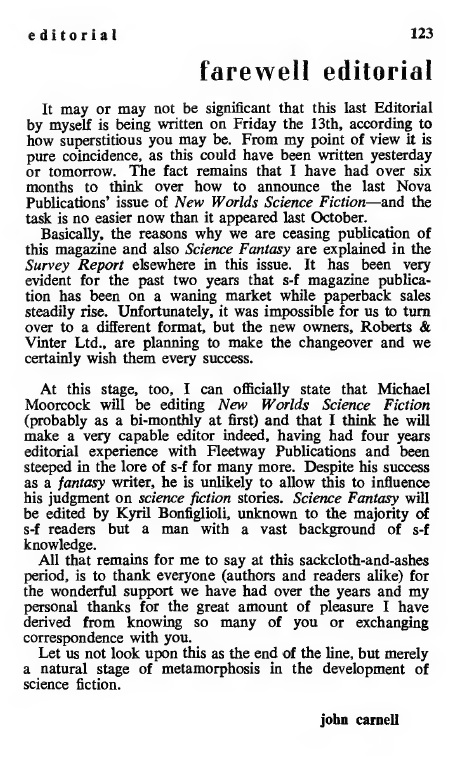
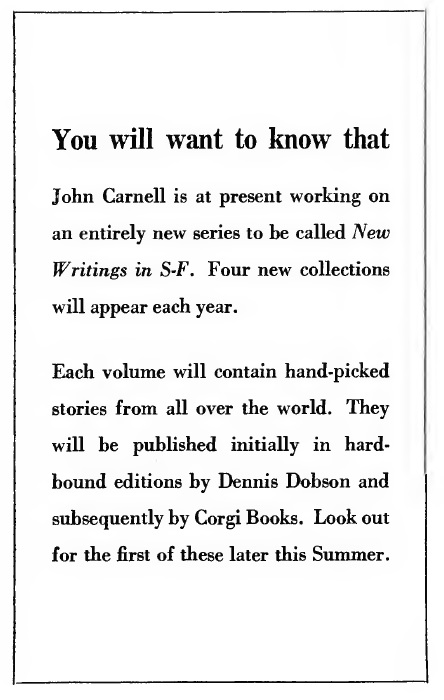
![[February 27, 1964] Beatles, Boredom and Ballard ( <i>New Worlds, March 1964</i>)](https://i0.wp.com/galacticjourney.org/wordpress/wp-content/uploads/2019/02/640227cover.jpg?resize=649%2C372)




